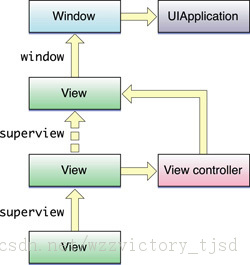NSOiOiOS触摸事件传递 2013-10-20
iOS系统是怎么找到发生触摸事件所在的视图的
触摸发生时,系统首先向根视图发送HitTest:WithEvent:消息,执行过程如下参考这里:
- It calls pointInside:withEvent:of self
- If the return is NO, hitTest:withEvent: returns nil. the end of the story.
- If the return is YES, it sends hitTest:withEvent: messages to its subviews. it starts from the top-level subview, and continues to other views until a subview returns a non-nil object, or all subviews receive the message.
- If a subview returns a non-nil object in the first time, the first hitTest:withEvent: returns that object. the end of the story.
- If no subview returns a non-nil object, the first hitTest:withEvent: returns self
触摸事件是如何传递的

上图中最底部的View即是在第一步中系统找到的发生触摸事件所在的视图。
如果View存在Ctroller,则先传递给Ctroller,否则就传递给superView.
HitTest:WithEvent:的应用
- 父视图中有布局重叠的且都可响应用户操作的对象,如:ScrollView and Button,如果Button在ScrollView下面,正常情况下Button是不会成为第一响应者的,如果想让Button可以响应在其布局内的触摸事件,可以在Button和ScrollView的父View中重写hitTest:withEvent方法(参考这里):
1 | - (UIView *)hitTest:(CGPoint)point withEvent:(UIEvent *)event { |
- UIView的子类不响应触摸事件,但其子View可以响应。通过设置userInteractionEnabled=NO,可以使UIView子类不响应触摸事件,但其会挟持子View,原因见3)这时,可以通过重写hitTest:withEvent来实现:(参考这里):
1 | -(id)hitTest:(CGPoint)point withEvent:(UIE:vent *)event { |
- userInteractionEnabled = NO的作用:使当前的hitTest:withEvent返回nil,其它的类似属性还有:Hidden=YES,alpha<0.01,,事件发生的点在子View的几何范围内,却超过了父View的几何范围(clipsToBounds=NO时可出现此种情况)
参考: